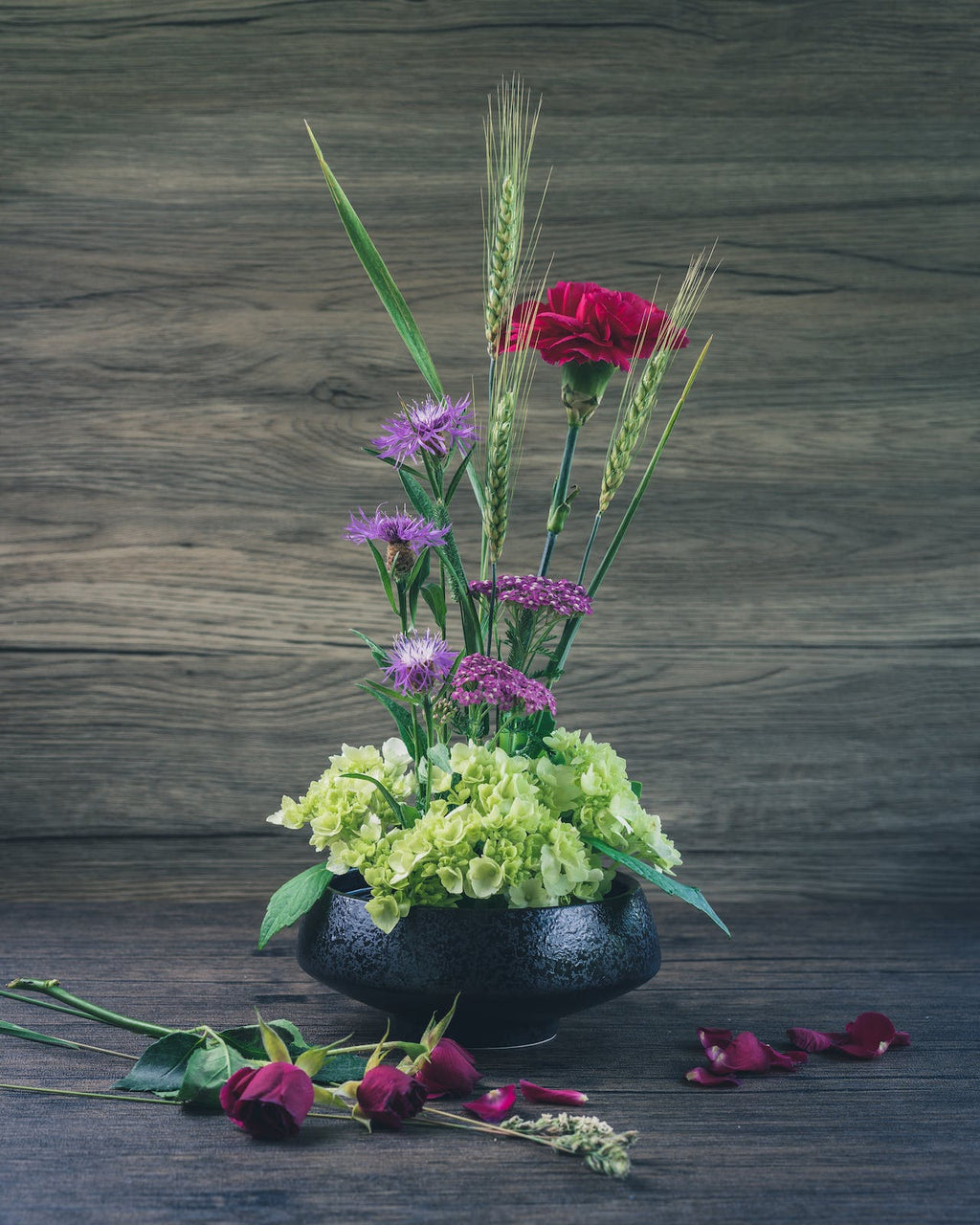Ikebana, the traditional Japanese art of flower arrangement, is not just about placing flowers in a vase. It is a meticulous and thoughtful process that involves creating a harmonious balance between nature, the container, and the surrounding space. In this Flowerbee guide, we will explore the steps to arrange an ikebana flower arrangement and appreciate the beauty and tranquility it brings to any space.
Arranging an ikebana flower arrangement is a meditative and artistic practice that allows you to connect with nature and create a serene atmosphere. By following these steps and embracing the principles of ikebana, you can create stunning arrangements that embody the essence of beauty and harmony.
Step 1: Gather the Materials
Before you begin, gather the necessary materials: a shallow container, a kenzan (a metal pin frog), floral shears, and a selection of flowers and foliage. Traditional ikebana arrangements often include three main elements: the shin (the main stem), the soe (the secondary stem), and the hikae (the supporting stem).
Step 2: Prepare the Container
Fill the container with water and place the kenzan inside. The kenzan will hold the stems in place and provide stability for the arrangement. Ensure that the kenzan is securely positioned in the center of the container.
Step 3: Choose the Main Stem
Select a visually striking stem to serve as the main focal point of your arrangement. Trim the stem at an angle and insert it into the kenzan, positioning it slightly off-center. The angle and placement of the main stem will determine the overall direction and balance of the arrangement.
Step 4: Add the Secondary Stems
Choose two or three secondary stems that complement the main stem in terms of color, texture, and length. Trim the stems at varying lengths and insert them into the kenzan, radiating outwards from the main stem. These secondary stems should enhance the overall shape and form of the arrangement.
Step 5: Include the Supporting Stems
Finally, add supporting stems to provide stability and fill any gaps in the arrangement. These stems should be shorter and less prominent than the main and secondary stems. Trim them at an angle and insert them into the kenzan, strategically placing them to create a sense of depth and balance.
Step 6: Consider Negative Space
Ikebana emphasizes the importance of negative space, known as "ma," which allows the viewer to appreciate the beauty of each individual element. As you arrange the flowers and foliage, consider the empty spaces and aim for a sense of simplicity and minimalism.
Step 7: Reflect and Adjust
Take a step back and observe your arrangement from different angles. Reflect on the balance, harmony, and overall aesthetic. Make any necessary adjustments to achieve the desired effect.
Step 8: Care and Maintenance
Once your ikebana arrangement is complete, it is important to care for it properly. Change the water regularly, trim the stems as needed, and remove any wilted or damaged flowers. With proper care, your ikebana arrangement can last for several days, bringing beauty and tranquility to your space.
日本花道藝術:一步一步
插花是日本傳統的插花藝術,不僅僅是將鮮花插在花瓶中。 這是一個細緻而深思熟慮的過程,涉及在自然、容器和周圍空間之間創造和諧的平衡。 在這本 Flowerbee 指南中,我們將探索佈置插花的步驟,並欣賞它為任何空間帶來的美麗和寧靜。
插花是一種冥想和藝術實踐,可以讓您與大自然聯繫並營造寧靜的氛圍。 透過遵循這些步驟並遵循花道原則,您可以創造出體現美麗與和諧本質的令人驚嘆的佈置。
第 1 步:收集材料
在開始之前,收集必要的材料:一個淺容器、一個 kenzan(金屬針蛙)、花剪以及精選的花朵和葉子。 傳統的花道佈置通常包括三個主要元素:脛(主莖)、soe(次要莖)和 hikae(支撐莖)。
步驟2:準備容器
將容器裝滿水,然後將 kenzan 放入其中。 kenzan 將把莖固定到位並為排列提供穩定性。 確保 kenzan 牢固地放置在容器的中心。
第三步:選擇主幹
選擇視覺上引人注目的莖作為您的佈置的主要焦點。 以一定角度修剪莖並將其插入 kenzan,使其稍微偏離中心。 主幹的角度和位置將決定整體的排列方向和平衡。
第四步:添加次要莖
選擇兩個或三個在顏色、質地和長度方面與主莖互補的次生莖。 將莖修剪成不同的長度,然後插入乾山,從主莖向外輻射。 這些次生莖應增強排列的整體形狀和形式。
步驟5:包括支撐莖
最後,添加支撐桿以提供穩定性並填充佈置中的任何間隙。 這些莖應比主莖和次莖更短且不那麼突出。 以一定角度修剪它們並將它們插入 kenzan,策略性地放置它們以創造深度和平衡感。
第六步:考慮負空間
花道強調負空間(稱為“ma”)的重要性,它使觀眾能夠欣賞每個單獨元素的美麗。 當您佈置花朵和葉子時,請考慮空白空間,並以簡約和極簡主義為目標。
第七步:反思與調整
退後一步,從不同角度觀察你的安排。 反思平衡、和諧和整體美感。 進行任何必要的調整以達到所需的效果。
第 8 步:保養與維護
花道佈置完成後,妥善保養牠非常重要。 定期換水,根據需要修剪莖,並除去任何枯萎或受損的花朵。 如果保養得當,您的花道可以持續數天,為您的空間帶來美麗和寧靜。



